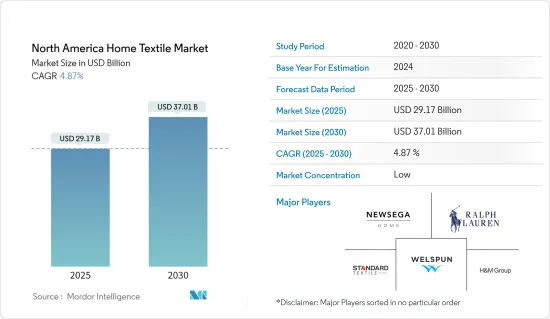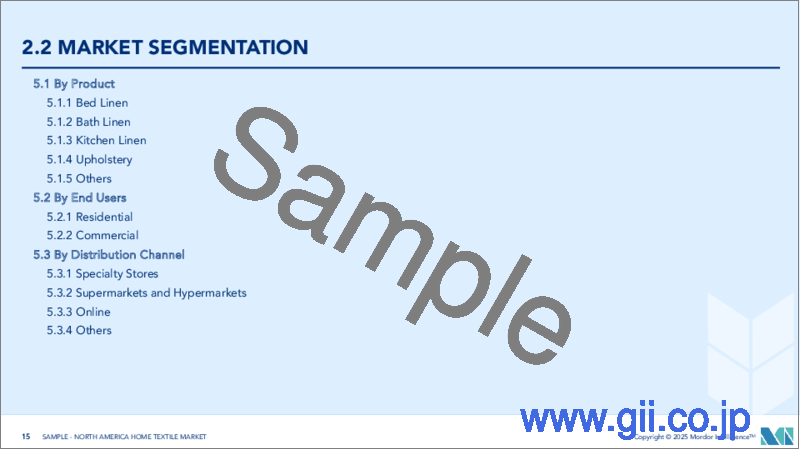|
|
市場調査レポート
商品コード
1630401
北米のホームテキスタイル:市場シェア分析、産業動向、成長予測(2025~2030年)North America Home Textile - Market Share Analysis, Industry Trends & Statistics, Growth Forecasts (2025 - 2030) |
||||||
カスタマイズ可能
適宜更新あり
|
|||||||
| 北米のホームテキスタイル:市場シェア分析、産業動向、成長予測(2025~2030年) |
|
出版日: 2025年01月05日
発行: Mordor Intelligence
ページ情報: 英文 140 Pages
納期: 2~3営業日
|
全表示
- 概要
- 目次
北米のホームテキスタイルの市場規模は2025年に291億7,000万米ドルと推定され、予測期間(2025-2030年)のCAGRは4.87%で、2030年には370億1,000万米ドルに達すると予測されます。

北米のホームテキスタイル市場は、雇用機会の継続的な拡大と可処分所得の同時増加によって力強い成長を遂げています。家庭用リネン製品への個人支出は大幅かつ指数関数的に増加しており、中でもベッドリネンとキッチンリネンが最も大幅な伸びを記録しています。
この地域では、新築プロジェクトの急増と単身世帯の増加が、消費者が新しい居住空間のために買い替え製品を求めているため、家庭用家具、特に家庭用繊維製品の需要を牽引しています。この動向は商業分野にも及んでおり、ホテル、リゾート、レストランでは、ベッド用テキスタイルを含む革新的なホームデコレーションアイテムを求める傾向が強まっており、ホームテキスタイルの需要をさらに押し上げています。最近の顕著な動向は、デジタルプリントされたホームテキスタイルへの関心が高まっていることで、メーカー各社は独創的な新製品を発表し、市場の需要に拍車をかけています。例えば、ニューサガホームテキスタイルは、掛け布団、シーツセット、枕カバー、ダストフリルなど、寝室に欠かせないテキスタイルを包括的にセットしたベッドインバッグのコンセプトを発表しました。
北米のホームテキスタイル市場動向
住宅建設と住宅リフォームの増加が市場の成長を促進
北米では、住宅建設と住宅リフォームが顕著に増加しています。この動向は、住宅セクターの成長と居住空間の改善に対する需要の急増に寄与する様々な要因によってもたらされています。北米全域で住宅建設プロジェクトが大幅に増加しています。人口増加、都市化、良好な経済状況に後押しされ、新築住宅の需要が急増しています。
住宅の改築プロジェクトは、寝室、居間、台所、浴室などの室内空間を向上させる。カーテンや寝具からタオルやその他の家庭用繊維製品に至るまで、こうしたリフォームに採用される製品は多岐にわたる。同時に、米国全土で新築住宅建設が顕著に増加しています。このような住宅建設活動の急増は、ホームテキスタイルの利用を促進するだけでなく、市場の拡大にも貢献しています。
北米のホームテキスタイル市場を独占する米国
米国は北米のホームテキスタイル市場をリードし、成長と業界動向に大きな影響を与えています。いくつかの市場促進要因が、この市場における米国の極めて重要な役割を裏付けています。
米国は広大で多様な消費者層を有し、購買力も高いです。この豊かさが、寝具やカーテンからラグや椅子張りまで、多様な家庭用繊維製品に対する強い需要を後押ししています。さらに、高品質かつ視覚的に魅力的なテキスタイルを好むアメリカの消費者は、製品提供の革新と多様化に拍車をかけています。
米国のホームテキスタイル市場をさらに活性化させているのは、ホームセンターやインテリアデザインの動向です。住宅所有者は空間の改築や美化に投資するため、美観と快適性を高める高級テキスタイルへの欲求が高まっています。この動向は、ホームデコレーションのテレビ番組やオンライン・インスピレーション・プラットフォームの人気、そしてパーソナライズされた家庭環境を重視する幅広い文化によって強化されています。
米国は洗練され確立されたサプライチェーンのインフラを享受しており、ホームテキスタイル市場を強化しています。多くの製造施設、流通拠点、小売店があり、効率的な生産と家庭用繊維製品の広範な入手が可能です。このような強固なインフラが競争市場を育成し、消費者に多様な製品を提供しています。
北米のホームテキスタイル産業の概要
北米のホームテキスタイル市場は断片化されており、多くのプレーヤーが存在します。同市場は予測期間中に成長する機会を提示しており、市場競争はさらに激化すると予想されます。競合情勢は、最大の市場シェアを獲得するためにプレーヤーが採用した買収や合併などのあらゆる戦略を示しています。主要プレイヤーは、Welspun Group、Ralph Lauren、New Sega Home textiles、Standard Textiles、H&M Groupなどです。
その他の特典:
- エクセル形式の市場予測(ME)シート
- 3ヶ月間のアナリストサポート
目次
第1章 イントロダクション
- 調査の前提条件と市場定義
- 調査範囲
第2章 調査手法
第3章 エグゼクティブサマリー
第4章 市場力学と洞察
- 市場概要
- 市場促進要因
- 幅広い繊維製品の入手可能性
- 持続可能で環境に優しい繊維製品に対する意識の高まり
- 市場抑制要因
- 消費者の価格感応度
- 市場機会
- オンライン繊維製品小売セクターの成長可能性
- インテリアデザイナーとのコラボレーション
- バリューチェーン分析
- 業界の魅力度ポーターのファイブフォース分析
- 新規参入業者の脅威
- 買い手の交渉力
- 供給企業の交渉力
- 代替品の脅威
- 競争企業間の敵対関係
- 業界の技術的進歩に関する洞察
- COVID-19の市場への影響
第5章 市場セグメンテーション
- 製品別
- ベッドリネン
- バスリネン
- キッチンリネン
- 室内装飾品
- その他
- エンドユーザー別
- 住宅リネン
- 商業
- 流通チャネル別
- 専門店
- スーパーマーケットとハイパーマーケット
- オンライン
- その他
第6章 競合情勢
- 市場集中度の概要
- 企業プロファイル
- Welspun Group
- Ralph Lauren
- Standard Textile
- New Sega Home textiles
- H&M Group
- American Textile Company
- DivaTex
- Calvin Klein Home
- Fabrica Maria
- Marvic Textiles
- Others
第7章 市場の将来
第8章 免責事項および出版社について
The North America Home Textile Market size is estimated at USD 29.17 billion in 2025, and is expected to reach USD 37.01 billion by 2030, at a CAGR of 4.87% during the forecast period (2025-2030).

The North American home textile market is experiencing robust growth, driven by continuous enhancements in employment opportunities and a simultaneous increase in disposable income. Personal expenditure on household linen products is rising significantly and exponentially, with bed and kitchen linen registering the most substantial growth.
The surge in new construction projects and the growing number of single-person households in the region drive the demand for home furnishings, particularly home textiles, as consumers seek replacement products for their new living spaces. This trend extends to the commercial sector, where hotels, resorts, and restaurants increasingly gravitate toward innovative home decor items, including bed textiles, further boosting the demand for home textiles. A notable recent trend is the escalating interest in digitally printed home textiles, prompting manufacturers to introduce new products creatively and fueling market demand. For example, New Saga Home Textile introduced the bed-in-a-bag concept, encompassing a comprehensive set of textiles essential for the bedroom, such as a comforter, sheet set, pillowcases, and dust ruffle.
North America Home Textile Market Trends
Increase in Residential Construction and Home Renovation is Fueling the Growth of the Market
North America is witnessing a notable increase in residential construction and home renovation activities. This trend is driven by various factors contributing to the growth of the housing sector and a surge in the demand for improved living spaces. There has been a substantial uptick in residential construction projects across North America. The demand for new homes has surged, fueled by population growth, urbanization, and favorable economic conditions.
Home renovation projects enhance interior spaces, including bedrooms, living rooms, kitchens, and bathrooms. Products employed for these updates range from curtains and bedding to towels and other home textile items. Concurrently, there is a notable uptick in new residential construction across the United States. This surge in residential construction activities not only boosts the utilization of home textiles but also contributes to the expansion of the market.
The United States Dominates North America's Home Textile Market
The United States leads the home textile market in North America, significantly influencing growth and industry trends. Several key market drivers underscore the country's pivotal role in this market.
The United States has a vast and varied consumer base with substantial purchasing power. This affluence fuels a strong demand for diverse home textile products, from bedding and curtains to rugs and upholstery. Moreover, American consumers' preference for high-quality and visually appealing textiles spurs innovation and diversification in product offerings.
A pronounced home improvement and interior design trend further buoy the US home textile market. As homeowners invest in renovating and beautifying their spaces, they have an increased appetite for premium textiles that elevate aesthetics and comfort. This trend is reinforced by the popularity of home decor TV shows, online inspiration platforms, and a broader culture emphasizing personalized home environments.
The United States enjoys a sophisticated and established supply chain infrastructure, bolstering its home textile market. With many manufacturing facilities, distribution hubs, and retail outlets, the country ensures efficient production and widespread availability of home textiles. Such a robust infrastructure cultivates a competitive market, offering consumers a diverse product range.
North America Home Textile Industry Overview
The North American home textile market is fragmented, with the presence of many players. The market presents opportunities for growth during the forecast period, which is expected to further increase market competition. The competitive landscape shows all strategies, such as acquisitions and mergers, adopted by players to gain the largest market share. The key players include Welspun Group, Ralph Lauren, New Sega Home textiles, Standard Textiles, and H&M Group.
Additional Benefits:
- The market estimate (ME) sheet in Excel format
- 3 months of analyst support
TABLE OF CONTENTS
1 INTRODUCTION
- 1.1 Study Assumptions and Market Definition
- 1.2 Scope of the Study
2 RESEARCH METHODOLOGY
3 EXECUTIVE SUMMARY
4 MARKET DYNAMICS AND INSIGHTS
- 4.1 Market Overview
- 4.2 Market Drivers
- 4.2.1 Availability of a Wide Range of Textile Product
- 4.2.2 Growing Awarness about Sustainable and Eco-friendly Textile Product
- 4.3 Market Restraints
- 4.3.1 Price Sensitivity of Consumer
- 4.4 Market Opportunities
- 4.4.1 Growing Potential in Online Textile Retail Sector
- 4.4.2 Collaboration with Interior Designers
- 4.5 Value Chain Analysis
- 4.6 Industry Attractiveness: Porter's Five Forces Analysis
- 4.6.1 Threat of New Entrants
- 4.6.2 Bargaining Power of Buyers
- 4.6.3 Bargaining Power of Suppliers
- 4.6.4 Threat of Substitutes
- 4.6.5 Intensity of Competitive Rivalry
- 4.7 Insights into Technological Advancements in the Industry
- 4.8 Impact of COVID-19 on the Market
5 MARKET SEGMENTATION
- 5.1 By Product
- 5.1.1 Bed Linen
- 5.1.2 Bath Linen
- 5.1.3 Kitchen Linen
- 5.1.4 Upholstery
- 5.1.5 Others
- 5.2 By End Users
- 5.2.1 Residential
- 5.2.2 Commercial
- 5.3 By Distribution Channel
- 5.3.1 Speciality Stores
- 5.3.2 Supermarkets and Hypermarkets
- 5.3.3 Online
- 5.3.4 Others
6 COMPETITIVE LANDSCAPE
- 6.1 Market Concentration Overview
- 6.2 Company Profiles
- 6.3 Welspun Group
- 6.4 Ralph Lauren
- 6.5 Standard Textile
- 6.6 New Sega Home textiles
- 6.7 H&M Group
- 6.8 American Textile Company
- 6.9 DivaTex
- 6.10 Calvin Klein Home
- 6.11 Fabrica Maria
- 6.12 Marvic Textiles
- 6.13 Others





